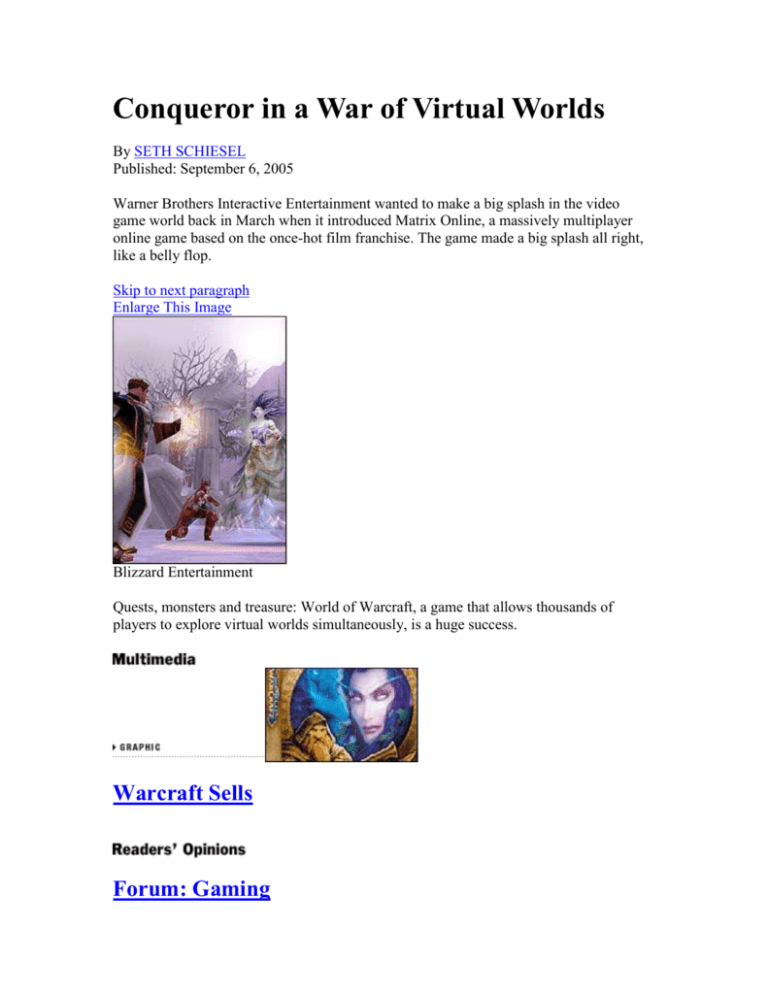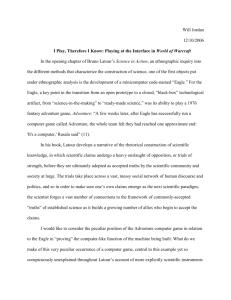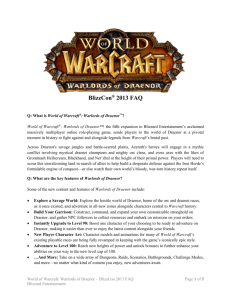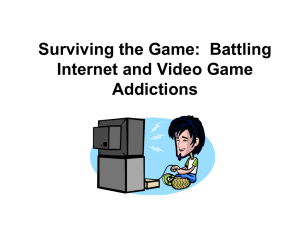Conqueror in a War of Virtual Worlds
advertisement

Conqueror in a War of Virtual Worlds By SETH SCHIESEL Published: September 6, 2005 Warner Brothers Interactive Entertainment wanted to make a big splash in the video game world back in March when it introduced Matrix Online, a massively multiplayer online game based on the once-hot film franchise. The game made a big splash all right, like a belly flop. Skip to next paragraph Enlarge This Image Blizzard Entertainment Quests, monsters and treasure: World of Warcraft, a game that allows thousands of players to explore virtual worlds simultaneously, is a huge success. Warcraft Sells Forum: Gaming Blizzard Entertainment A scene from "World of Warcraft." Over its first three months the game signed up fewer than 50,000 subscribers, a pittance, so in June Warner cut bait and agreed to sell the game to Sony. Last month Matrix Online was downsized from nine virtual "realms" to three, because users were having a hard time finding one another in the game's vast digital ghost town. The troubles of Matrix Online were partly of Warner's own making; many players and critics agree that the game is a mediocre experience. But the online market used to make room for mediocre games. Now, the broader phenomenon is that so many contenders, including Matrix Online, simply cannot stand up to the overwhelming popularity of online gaming's new leviathan: World of Warcraft, made by Blizzard Entertainment, based in Irvine, Calif. With its finely polished, subtly humorous rendition of fantasy gaming - complete with mages, orcs, dragons and demons - World of Warcraft has become such a runaway success that it is now prompting a debate about whether it is helping the overall industry by bringing millions of new players into subscription-based online gaming or hurting the sector by diverting so many dollars and players from other titles. "World of Warcraft is completely owning the online game space right now," said Chris Kramer, a spokesman for Sony Online Entertainment, buyer of Matrix Online and one of Blizzard's chief rivals. "Look, Matrix Online is good, but it's like being in the early 90's and trying to put a fighting game up against Mortal Kombat or Street Fighter; it's just not going to happen. There are a lot of other online games that are just sucking wind right now because so many people are playing WOW." Mr. Kramer is in a position to know. Last November, his company released EverQuest II, sequel to the previous champion of massively multiplayer games. Such games, also known as M.M.O.'s, allow hundreds or thousands of players to simultaneously explore vast virtual worlds stocked with quests, monsters and treasure. Players sometimes cooperate to take on epic tasks, like killing a huge computer-controlled dragon, and sometimes fight one another in what is known as player-versus-player combat. But November was the same month that World of Warcraft hit the shelves. In a subscriber-based multiplayer online game, the customer buys the game's software for perhaps $30 to $50, and then pays a monthly fee of usually around $15. (There are also many games that are sold at retail but then are free to play online.) Since November, World of Warcraft has signed up more than four million subscribers worldwide, making for an annual revenue stream of more than $700 million. About a million of those subscribers are in the United States (with more than half a million copies sold this year) and another 1.5 million are in China, where the game was introduced just three months ago. By contrast, EverQuest II now has between 450,000 and 500,000 subscribers worldwide, with about 80 percent in the United States. Just a year ago, numbers like that would have classed EverQuest II as a big hit. The original EverQuest topped out at around a half-million players, and many, if not most, game executives came to believe that the pool of people willing to pay $15 a month to play a video game had been exhausted. The conventional wisdom in the industry then was that there could not possibly be more than a million people who would pay to play a massively multiplayer online game. Now, World of Warcraft has shattered earlier assumptions about the potential size of the market. "For many years the gaming industry has been struggling to find a way to get Internet gaming into the mainstream," said Jeff Green, editor in chief of Computer Gaming World, one of the top computer game magazines. "These kinds of games have had hundreds of thousands of players, which are not small numbers, but until World of Warcraft came along no one has been able to get the kind of mainstream numbers that everyone has wanted, which is millions of players." (Page 2 of 2) Or as put by another Blizzard rival, Richard Garriott, an executive producer at NCsoft and one of the fathers of computer role-playing games: "Every year someone writes a big article about how the M.M.O. business has reached a new plateau and won't get any bigger. And then every year we seem to grow 100 percent. World of Warcraft is just the next big step in that process." Skip to next paragraph Warcraft Sells Worldwide, about the only subscriber-based multiplayer online games that can compare to World of Warcraft are Lineage and Lineage II, from NCsoft. Each game claims about 1.8 million subscribers, but in both cases the vast majority of players are in South Korea, where Internet gaming has become practically a national pastime. World of Warcraft has taken off in many countries because Blizzard has made a game that is easy for casual players to understand and feel successful in, while including enough depth to engross serious gamers, who may play a game like World of Warcraft for 30 hours a week or more. Previously, many massively multiplayer games had seemed to pride themselves on their difficulty and arcane control schemes. "The emphasis has clearly been on removing all sorts of barriers of entry," Ville Lehtonen, a 25-year-old Finn who runs Ascent, one of Word of Warcraft's elite player organizations, or guilds, said via e-mail. "The low-end game is a great triumph of usability - everything is aesthetically pleasing and easy to learn, making the experience a very positive one. Also the ease of leveling guaranteed that people didn't get frustrated too easily. These effects combined to lure in the so-called casual crowds in huge masses." It is much the same formula that Blizzard has used with its other major properties: the action-role playing Diablo series and the Starcraft and Warcraft strategy franchises. "This is what Blizzard always does," said Mr. Green, of Computer Gaming World. "They have an innate genius at taking these genres that are considered hard-core geek property and repolishing them so they are accessible to the mainstream. To do that without losing their geek cred is an incredible achievement." Mike Morhaime, president of Blizzard, which is controlled by Vivendi Universal Games, estimated that about a quarter of the game's players are women, up from fewer than 10 percent on previous Blizzard games. "I think we've introduced a number of people to online gaming who didn't realize that they would even enjoy it, and so I think that's good for the industry," he said. Some of Blizzard's biggest rivals seem to agree. "World of Warcraft is absolutely expanding the market, and that's a positive for us because we don't want this to just be a niche market," said Mike Crouch, an NCsoft spokesman. NCsoft has at least three new massively multiplayer games on the way including City of Villains, a superhero-themed sequel to last year's City of Heroes that is scheduled for release this fall. "World of Warcraft is great, but people eventually move on and we will have the catalog for them to move on to." But there is also trepidation. "If you're only playing WOW and you're paying every single month, what does that mean for all of the other Internet games out there that are trying to get your $10 or $12 or $15 a month?" Mr. Green said. "WOW is now the 800-pound gorilla in the room. I think it also applies to the single-player games. If some kid is paying $15 a month on top of the initial $50 investment and is devoting so many hours a week to it, are they really going to go out and buy the next Need for Speed or whatever? There is a real fear that this game, with its incredible time investment, will really cut into game-buying across the industry." In any case, as in years past, there are those who believe that paid online gaming is all a fad anyway. "I don't think there are four million people in the world who really want to play online games every month," said Michael Pachter, a research analyst for Wedbush Morgan, a securities firm. "World of Warcraft is such an exception. I frankly think it's the buzz factor, and eventually it will come back to the mean, maybe a million subscribers." "It may continue to grow in China," Mr. Pachter added, "but not in Europe or the U.S. We don't need the imaginary outlet to feel a sense of accomplishment here. It just doesn't work in the U.S. It just doesn't make any sense." Related Articles TECHNOLOGY; A Hand-Held That Doesn't Just Play Games (August 29, 2005) $ Raids Aim at Web Piracy (July 1, 2005) $ TECHNOLOGY; Sony Unveils Details About PlayStation 3 (May 17, 2005) $ TECHNOLOGY; In Console Wars, Xbox Is Latest to Rearm (May 13, 2005) $ Forum: Gaming








